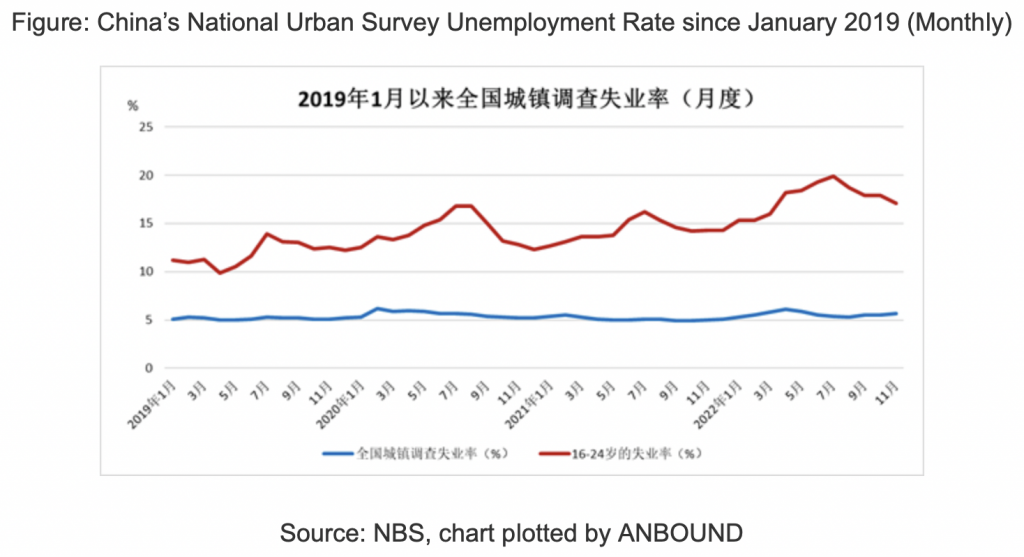China’s Unemployment Problem Could Be More Serious Than Statistics Imply – Analysis
By Anbound
By He Jun
China is now facing a severe unemployment issue, and its magnitude s likely to be significantly underestimated previously.
According to data from the country’s National Bureau of Statistics (NBS), from January to November 2022, the average surveyed urban unemployment rate across the country was 5.6%. In the same month, the national surveyed urban unemployment rate was 5.7%, an increase of 0.2 percentage points from October. The unemployment rate of the local household registration labor force survey was 5.5%. For non-local household registration labor, it was 6.2%. For the labor force aged 16-24, the unemployment rate was 17.1%, a decrease of 0.8 percentage points from the previous month. For those aged 25-59, it was 5.0%, an increase of 0.3 percentage points from the previous month. The rate in 31 large cities and towns of the country was 6.7%.
In terms of employment, the result appears to be rather impressive. From January to November this year, 11.45 million new jobs were created in cities and towns across the country, completing the annual target of 11 million ahead of schedule. The number of re-employed urban unemployed reached 4.76 million in the first 11 months, and the number of employed people with employment difficulties reached 1.63 million people. The relevant person in charge of the NBS stated that China’s employment situation is stable, and there are still many favorable conditions for the gradual improvement of the situation in the next stage.
From the official data, it seems that there is no abnormality. However, judging from the development status of China’s domestic enterprises, especially small and medium-sized enterprises, and the reports on unemployment status in the market, such official unemployment data may not fully reflect the real situation. While this view is not based on strict surveys or statistics, is still based on incomplete observation of multiple information windows related to employment. Researchers at ANBOUND believe that if the unemployment problem cannot be truly understood, it may affect the formulation of relevant employment policies, and some economic policies may not give enough weight to the issue. If the policies focus on boosting GDP while ignoring employment, the effect of stabilizing the economy and society may be compromised.
There are many reasons for the aggravation of China’s unemployment problem, such as the downward trend of the economy, business contraction or a large number of bankruptcies, and the impact of the COVID-19 outbreaks. The last factor mentioned here, i.e., the pandemic, is the aspect that has the greatest impact on unemployment. The official also admitted that in November, due to the large-scale rebound of the novel coronavirus outbreaks and the increasing difficulties in the production and operation of enterprises, employment pressure has increased.
In the opinion of ANBOUND, there are several crucial points that the Chinese authorities need to be paid close attention to.
The first is unemployment among the youth. Young people are the group with the highest unemployment rate. In November this year, the labor force survey unemployment rate of 16-24 years old was 17.1%, which was much higher than the overall result. Within this, college graduates are a key group for employment. The number of college graduates nationwide in 2022 was 10.76 million, and the number of college graduates in 2023 is expected to reach 11.58 million, a year-on-year increase of 820,000. In addition to college graduates with higher levels of education, there are also a large number of young employment groups who are not college graduates. Researchers at ANBOUND learned that younger populations in the Pearl River Delta, Yangtze River Delta, and other areas where a large number of manufacturing industries are concentrated have encountered “the most difficult employment season in history” this year.
Second, the problem of hidden unemployment has become more serious. The official urban surveyed unemployment rate is calculated through the urban employment and unemployment summary data obtained from the urban labor force sample survey. If the survey does not cover a certain population, it will then not be reflected in the unemployment rate. In real life, some short-term unemployed people do not want to be included in unemployment statistics, but their real status is actually unemployed. Under the impact of the three-year-long COVID-19 pandemic, the hidden unemployment population in China is real and there are a large number of them. Although not reflected in unemployment statistics, their behavior of having no income or low income and reducing consumption is a reality.
The third is widespread continuous unemployment in economically backward areas. In general, the impact of the COVID-19 pandemic on employment is much more strongly felt in the large population and economically backward areas than those developed ones. For example, in the Northeast region, in recent years, there has been a relatively common phenomenon of “contiguous unemployment”, that is, large-scale unemployment in some areas, resulting in severe regional unemployment. This, in turn, has evolved into broader social despair and social collapse. Media reports show that there has been a cycle of unemployment in the Northeast region of the country, where the last of such a cycle took place two decades ago in the reform of state-owned enterprises. Now, the children of those who experienced unemployment twenty years ago are undergoing what their parents had been through. In some families, there are two generations of people being unemployed simultaneously, and this has become a new social problem in the country.
The gradually deteriorating unemployment problem in China poses a real challenge in achieving stable employment in a stable economy. Undoubtedly, this is a huge, complex, and subtle issue, and it is also a territory unfamiliar to many of the governments at different levels that have long been accustomed to rapid development. This is especially true when unemployment has never been an important indicator of government performance appraisal, hence it has not received much attention. However, the situation is different now. Because of the serious damage felt by the economy in recent years, China’s working class has become very vulnerable to unemployment, where the problem of maintaining survival daily necessities like food and medicines has become extremely real. If this is not resolved properly, it will escalate into a social problem. It should also be noted that since the unemployment problem is mainly borne by individuals and families, its dispersion effect makes it difficult to agglomerate as a major or intense issue that arouses social concern, therefore it often does not attract the attention of government departments.
Final analysis conclusion:
Facing the worsening unemployment problem, Chinese economic and social policies in the future will need to be focusing job creation, increasing residents’ income, and enhancing business development. As the unemployment problem is directly related to the livelihood of the people, this makes it an important basic issue that may affect their satisfaction level.
He Jun is a researcher at ANBOUND


